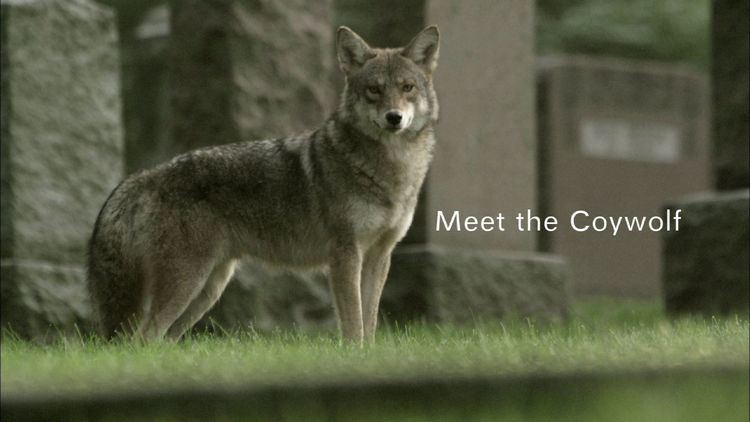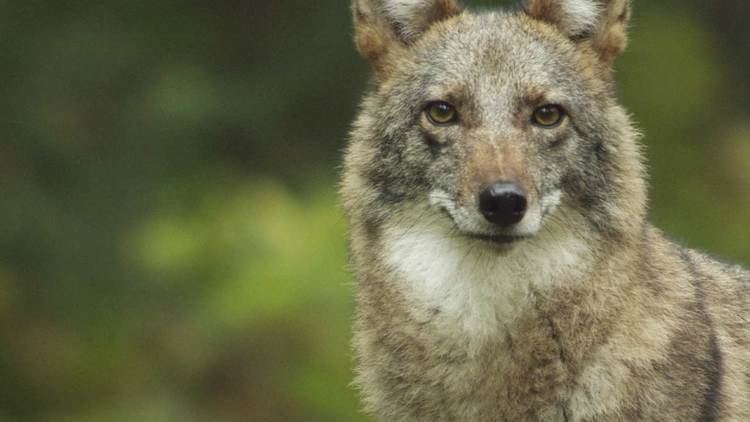Kingdom Animalia Family Canidae Species C. latrans × C. lupus Rank Hybrid | Class Mammalia Phylum Chordata Order Carnivores | |
Scientific name Canis latrans x Canis lupus Similar Eastern coyote, Coydog, Wholphin, Coyote, Cama | ||
Meet the coywolf a new hybrid carnivore roams the city metrofocus
Coywolf (sometimes called woyote) is an informal term for a canid hybrid descended from coyotes and gray wolves. Hybridization between the two species is facilitated by the fact that they diverged relatively recently (around 6,000–117,000 years ago). Genomic studies indicate that nearly all North American gray wolf populations possess some degree of admixture with coyotes following a geographic cline, with the lowest levels occurring in Alaska, but the highest in Ontario and Quebec as well as Atlantic Canada.
Contents
- Meet the coywolf a new hybrid carnivore roams the city metrofocus
- Description
- Eastern coyotes
- Red and eastern wolves
- Mexican gray wolf coyote hybrids
- Northwestern gray wolf coyote hybrids
- Coydogs
- References

Description

Hybrids of any combination tend to be larger than coyotes, and show behaviors intermediate between coyotes and the other parent's species. In one captive hybrid experiment, six F1 hybrid pups from a male northwestern gray wolf and a female coyote were measured shortly after birth with an average on their weights, total lengths, head lengths, body lengths, hind foot lengths, shoulder circumferences, and head circumferences compared with those on pure coyote pups at birth. Despite being delivered by a female coyote, the hybrid pups at birth were much larger and heavier than regular coyote pups born and measured around the same time. At six months of age, these hybrids were closely monitored at the Wildlife Science Center. Executive Director Peggy Callahan at the facility states that the howls of these hybrids are said to start off much like regular gray wolves with a deep strong vocalization, but changes partway into a coyote-like high pitched yipping.

Compared with pure coyotes, eastern wolf-coyote hybrids form more cooperative social groups and are generally less aggressive with each other while playing. Hybrids also reach sexual maturity when they are two years old, which is much later than occurs in pure coyotes.
Eastern coyotes

Eastern coyotes range from New England, New York, New Jersey, Pennsylvania, Ohio, West Virginia, Maryland, and Virginia. Their range also occurs in the Canadian provinces of Ontario, Quebec, New Brunswick, Nova Scotia, and Newfoundland and Labrador. Coyotes and wolves hybridized in the Great Lakes region, followed by an eastern coyote expansion, creating the largest mammalian hybrid zone known. Extensive hunting of gray wolves over a period of 400 years caused a population decline that reduced the number of suitable mates, thus facilitating coyote genes swamping into the eastern wolf population. This has caused concern over the purity of remaining wolves in the area, and the resulting eastern coyotes are too small to substitute for pure wolves as apex predators of moose and deer. The main nucleus of pure eastern wolves is currently concentrated within Algonquin Provincial Park. This susceptibility to hybridization led to the eastern wolf being listed as Special Concern under the Canadian Committee on the Status of Endangered Wildlife and with the Committee on the Status of Species at Risk in Ontario. By 2001, protection was extended to eastern wolves occurring on the outskirts of the park, thus no longer depriving Park eastern wolves of future pure-blooded mates. By 2012, the genetic composition of the park's eastern wolves was roughly restored to what it was in the mid-1960s, rather than in the 1980s–1990s, when the majority of wolves had large amounts of coyote DNA.

Aside from the combinations of coyotes and eastern wolves making up most of the modern day eastern coyote's gene pools, some of the coyotes in the northeastern USA also have mild domestic dog (C. lupus familiaris) and western Great Plains gray wolf (C. l. nubilus) influences in their gene pool, thus suggesting that the eastern coyote is actually a four-in-one hybrid of coyotes, eastern wolves, western gray wolves, and dogs, and that the hybrids living in areas with higher white-tailed deer density often have higher degrees of wolf genes than those living in urban environments. The addition of domestic dog genes may have played a minor role in facilitating the eastern hybrids' adaptability to survive in human-developed areas. The four-in-one hybrid theory was further explored in 2014, when Monzón and his team subsequently reanalyzed the tissue and SNP samples taken from 425 eastern coyotes to determine the degree of wolf and dog introgressions involved in each geographic range. The domestic dog allele averages 10% of the eastern coyote's genepool, while 26% is contributed by a cluster of both eastern wolves and western gray wolves. The remaining 64% matched mostly with coyotes. This analysis suggested that prior to the uniformity of its modern-day genetic makeup, multiple swarms of genetic exchanges between the coyotes, feral dogs, and the two distinct wolf populations present in the Great Lakes region may have occurred, and urban environments often favor coyote genes, while the ones in the rural and deep forest areas maintain higher levels of wolf content. A 2016 meta-analysis of 25 genetics studies from 1995–2013 found that the northeastern coywolf is 60% western coyote, 30% eastern wolf, and 10% domestic dog. However, this hybrid canid is only now coming into contact with the southern wave of coyote migration into the southern United States.
Red and eastern wolves

The taxonomy of the red and eastern wolf of the Southeastern United States and the Great Lakes region, respectively, has been long debated, with various schools of thought advocating that they represent either unique species or results of varying degrees of gray wolf-coyote admixture.
In May 2011, an examination of 48,000 single nucleotide polymorphisms in red wolves, eastern wolves, gray wolves, and dogs indicated that the two were hybrid species, with the red wolf being 76% coyote and only 20% gray wolf, and the eastern wolf being 58% gray wolf and 42% coyote, finding no evidence of being distinct species in either. The study was criticized for having used red wolves with recent coyote ancestry, and a reanalysis in 2012 indicated that it suffered from insufficient sampling. A comprehensive review in 2012 further argued that the study's dog samples were unrepresentative of the species' global diversity, having been limited to boxers and poodles, and that the red wolf samples came from modern rather than historical specimens. The review was itself criticized by a panel of scientists selected for an independent peer review of its findings by the USFWS, which noted that the study's conclusion that the eastern wolf's two unique nonrecombining markers were insufficient to justify full-species status for the animal.
In 2016, a whole-genome DNA study suggested that all of the North American canids, both wolves and coyotes, diverged from a common ancestor 6,000–117,000 years ago. The whole-genome sequence analysis shows that two endemic species of North American wolf, the red wolf and eastern wolf, are admixtures of the coyote and gray wolf.
Mexican gray wolf-coyote hybrids
In a study that analyzed the molecular genetics of coyotes, as well as samples of historical red wolves and Mexican gray wolves from Texas, a few coyote genetic markers have been found in the historical samples of some isolated Mexican gray wolf individuals. Likewise, gray wolf Y chromosomes have also been found in a few individual male Texan coyotes. This study suggested that although the Mexican gray wolf is generally less prone to hybridizations with coyotes, exceptional genetic exchanges with the Texan coyotes may have occurred among individual gray wolves from historical remnants before the population was completely extirpated in Texas. The resulting hybrids would later on melt back into the coyote populations as the wolves disappeared. However, the same study also discussed an alternative possibility that the red wolves, which in turn also once overlapped with both species in the central Texas, were involved in circuiting the gene flows between the coyotes and gray wolves much like how the eastern wolf is suspected to have bridged gene flows between gray wolves and coyotes in the Great Lakes region since direct hybridizations between coyotes and gray wolves is considered rare. In tests performed on a stuffed carcass of what was initially labelled a chupacabra, mitochondrial DNA analysis conducted by Texas State University showed that it was a coyote, though subsequent tests revealed that it was a coyote–gray wolf hybrid sired by a male Mexican gray wolf.
Northwestern gray wolf-coyote hybrids
In 2013, the U.S. Department of Agriculture Wildlife Services conducted a captive-breeding experiment at their National Wildlife Research Center Predator Research Facility in Logan, Utah. Using gray wolves from British Columbia and western coyotes, they produced six hybrids, making this the first hybridization case between pure coyotes and northwestern gray wolves. The experiment, which used artificial insemination, was intended to determine whether or not the sperm of the larger gray wolves in the west was capable of fertilizing the egg cells of western coyotes. Aside from the historical hybridizations between coyotes and the smaller Mexican gray wolves in the south, as well as with eastern wolves and red wolves, grays wolves from the northwestern USA and western provinces of Canada were not known to interbreed with coyotes in the wild, thus prompting the experiment. The six resulting hybrids included four males and two females. At six months of age, the hybrids were closely monitored and were shown to display both physical and behavioral characteristics from both species, as well as some physical similarities to the eastern wolves, whose status as a distinct wolf species or as a genetically distinct subspecies of the gray wolf is controversial. Regardless, the result of this experiment concluded that northwestern gray wolves, much like the eastern wolves, red wolves, Mexican gray wolves, and domestic dogs, are capable of hybridizing with coyotes.
In 2015, a research team from the cell and microbiology department of Anoka-Ramsey Community College revealed that an F2 litter of two pups had been produced from two of the original hybrids. At the same time, despite the six F1's successful delivery from the same coyote, they were not all full siblings because multiple sperm from eight different northwestern gray wolves were used in their production. The successful production of the F2 litter, nonetheless, confirmed that hybrids of coyotes and northwestern gray wolves are just as fertile as hybrids of coyotes to eastern and red wolves. Both the F1 and F2 hybrids were found to be phenotypically intermediate between the western gray wolves and coyotes. Unlike the F1 hybrids, which were produced via artificial insemination, the F2 litter was produced from a natural breeding. The study also discovered through sequencing 16S ribosomal RNA encoding genes that the F1 hybrids all have an intestinal microbiome distinct from both parent species, but were once reported to be present in some gray wolves. Moreover, analysis of their complementary DNA and ribosomal RNA revealed that the hybrids have very differential gene expressions compared to those in gray wolf controls.
Coydogs
Hybrids between coyotes and domestic dogs have been bred in captivity dating back to the pre-Columbian Mexico. Other specimens were later produced by mammalian biologists mostly for research purposes. Although the latter species are not often considered wolves outside of the scientific community, domestic dogs are still subsumed into the gray wolf species hence coydogs are another biological sub-variations of hybrids between coyotes and gray wolves; the latter considered the domesticated form of Canis lupus. Some roaming primitive dogs in North America, such as the Carolina dogs from the southeastern United States, are also suspected to have had historical genetic exchanges with coyotes. Unlike other gray wolf subspecies, dogs have been known to freely hybridize with any Canis species that come into contact with them during the breeding seasons, which gives them the potential to introgress into various wild wolf and coyote populations.
